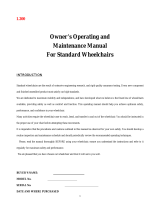
5
SAFETY/HANDLING
S
A
F
E
T
Y
&
H
A
N
D
L
I
N
G
SAFETY/HANDLING OF WHEELCHAIRS
COPING WITH EVERYDAY OBSTACLES
Coping with the irritation of everyday obstacles can
be alleviated somewhat by learning how to manage
your wheelchair. Keep in mind your center of grav-
ity to maintain stability and balance.
A NOTE TO WHEELCHAIR ASSISTANTS
When assistance to the wheelchair user is required,
remember to use good body mechanics. Keep your
back straight and bend your knees whenever tilting
the wheelchair or traversing curbs, or other impedi-
ments.
Also, be aware of any removable (detachable) parts.
These must NEVER be used for hand-held or lifting
supports, as they may be inadvertently released,
resulting in possible injury to the user and/or
assistant(s).
When learning a new assistance technique, have
an experienced assistant help you before attempt-
ing it alone.
TILTING
WARNING
DO NOT tilt the wheelchair without assistance.
When tilting the wheelchair, an assistant should
grasp the back of the wheelchair on a non-remov-
able (non-detachable) part. Inform the wheelchair
occupant before tilting the wheelchair and remind
him/her to lean back. Be sure the occupant’s feet
and hands are clear of all wheels.
TILTING - CURBS:
After mastering the techniques of tilting the wheel-
chair, use one (1) of the following procedures to
tackle curbs, short stairs, etc.:
METHOD 1
Assistant should apply a continuous downward
motion on the step tube of the wheelchair frame un-
til the balance point is achieved and the front cast-
ers clear the curb. At this point, the assistant will
feel a difference in the weight distribution.
“Safety and Handling” of the wheelchair requires the
close attention of the wheelchair user as well as the
assistant. This manual points out the most common
procedures and techniques involved in the safe op-
eration and maintenance of the wheelchair. It is im-
portant to practice and master these safe techniques
until you are comfortable in maneuvering around the
frequently encountered architectural barriers.
Use this information only as a “basic” guide. The
techniques that are discussed on the following pages
have been used successfully by many.
Individual wheelchair users often develop skills to
deal with daily living activities that may differ from
those described in this manual. Invacare recognizes
and encourages each individual to try what works
best for him/her in overcoming architectural ob-
stacles that they may encounter. Techniques in this
manual are a starting point for the new wheelchair
user and assistant with “safety” as the most impor-
tant consideration for all.
STABILITY AND BALANCE
WARNING
ALWAYS wear your Seat Positioning Strap. In-
asmuch as the SEAT POSITIONING STRAP is
an option on this wheelchair (You may order
with or without the Seat Positioning Strap),
Invacare strongly recommends ordering the
Seat Positioning Strap as an additional safe-
guard for the wheelchair user.
To assure stability and proper operation of your
wheelchair, you must at all times wear your Seat
Positioning Strap and maintain proper balance. Your
wheelchair has been designed to remain upright and
stable during normal daily activities as long as you
do not move beyond the center of gravity.
DO NOT lean forward out of the wheelchair any fur-
ther than the length of the armrests. Make sure the
casters are pointing in the forward position when-
ever you lean forward. This can be achieved by ad-
vancing the wheelchair and then reversing it in a
straight line.






















